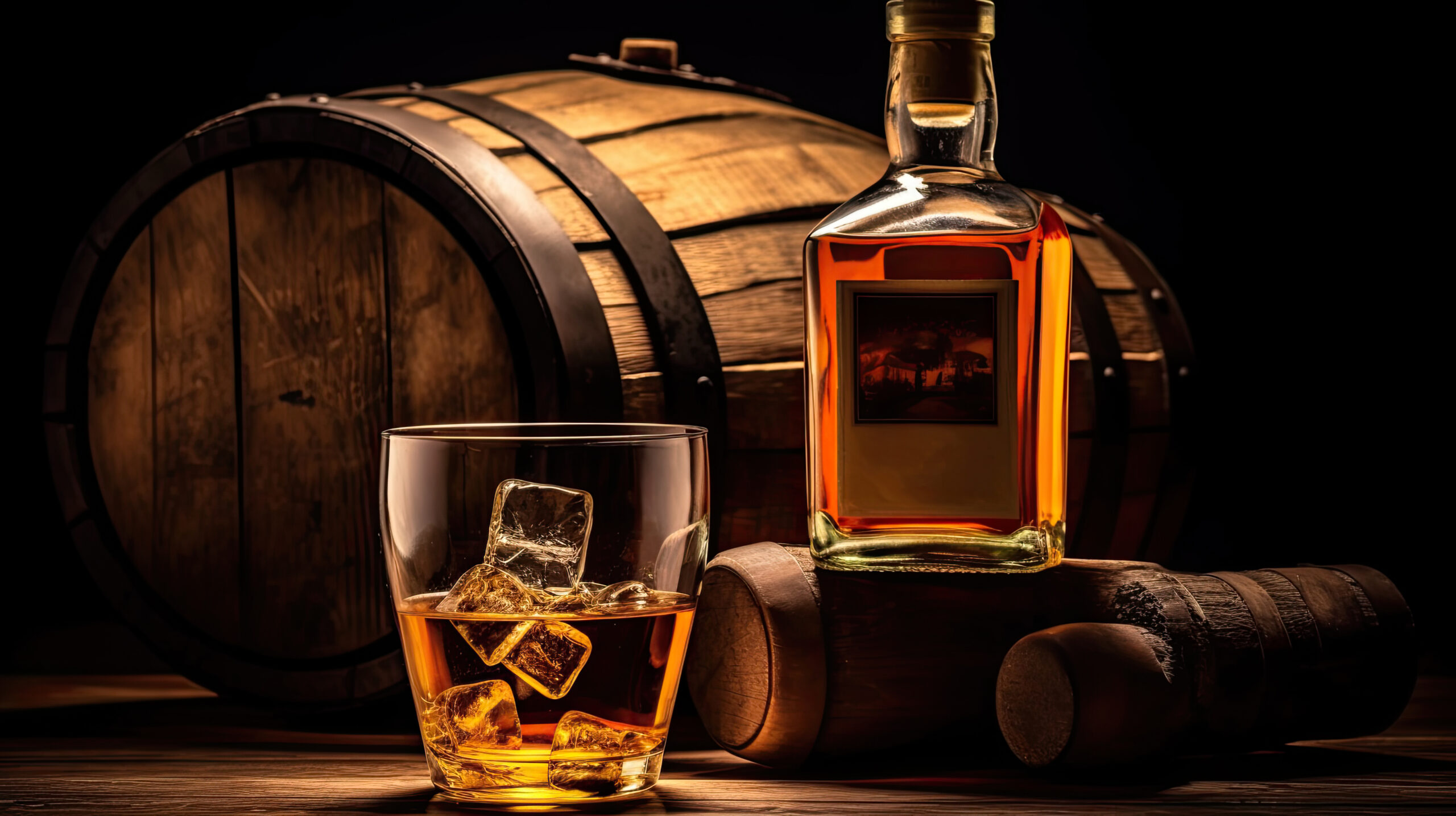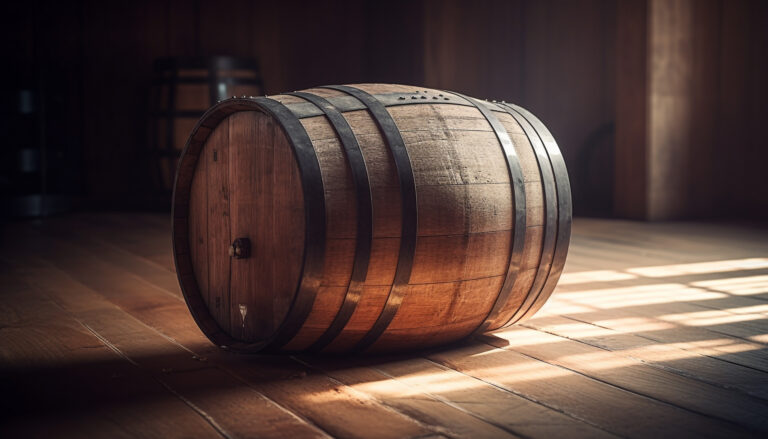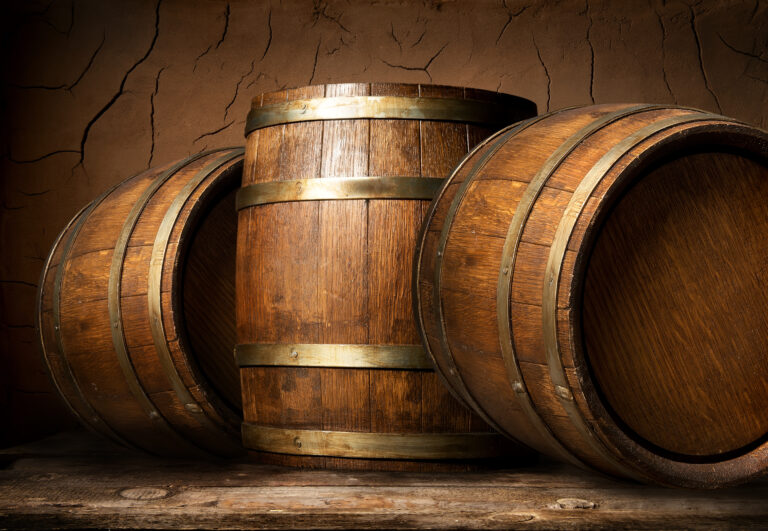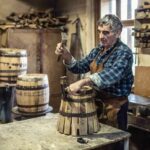You’ve probably heard endless chatter about how crucial whiskey aging is and how selecting the perfect barrel can unlock incredible, complex flavors. But here’s a factor that often flies under the radar: barrel size. It might seem like a small detail, but it profoundly impacts the taste of your favorite dram. The magic really happens with the volume of liquid interacting with the charred oak surface area, driving those essential chemical reactions that infuse distinct aromas and tastes. Just picture it – more surface area means more opportunities for the whiskey to pull out those delightful compounds from the wood.
Introduction: Why Barrel Size is a Big Deal in Whiskey Maturation
As a true whiskey aficionado, you know that barrel size isn’t just a detail; it’s a key player in how your cherished spirit ages and develops its unique flavor profile. The dimensions of the barrel dictate how much of that precious whiskey is exposed to the wood, influencing everything from its rich color and inviting aroma to its intricate taste.
Small barrels, typically ranging from 5 to 30 gallons, offer a higher surface area to volume ratio, meaning more of the whiskey gets up close and personal with the wood. This accelerated contact means the whiskey rapidly soaks up classic barrel flavors like vanilla, caramel, and spice. The only hitch? These smaller vessels can sometimes lead to over-oaking, potentially giving your whiskey an unwanted bitter edge.
On the flip side, large barrels, usually 55 gallons and beyond, have a lower surface area to volume ratio. This means the whiskey takes its sweet time, developing flavors more gradually, often leading to a mellow, smoky, or nutty character. However, in shorter aging periods, larger barrels might not offer enough wood exposure for a truly robust flavor development.
For most distillers, the sweet spot seems to be mid-sized barrels, typically in the 30 to 55-gallon range. These offer a fantastic balance, producing whiskey with harmonized vanilla and oak flavors over a reasonable 3 to 10-year aging period. Many successful makers of bourbon, rye, and other whiskey styles swear by this size range.
Ultimately, the choice of barrel size often boils down to personal preference and how long you’re willing to wait for that ideal glass of whiskey. Whether you’re craving an oak-forward small batch or a beautifully aged, smoky spirit, when it comes to whiskey maturation, size truly does matter.
Small Barrels vs. Large Barrels: The Surface Area to Volume Ratio Breakdown
When it comes to whiskey maturation, the surface area to volume ratio within a barrel is a game-changer for how the spirit evolves. It’s a fundamental aspect of barrel aging that dictates flavor intensity and speed.
Small Barrels vs. Large Barrels
The rule of thumb is simple: the smaller the barrel, the higher its surface area to volume ratio. This means more of the whiskey is constantly mingling with the wood, leading to faster aging and more intense wood-derived flavors. You’ll often find many craft distilleries leveraging small 5- to 15-gallon barrels to accelerate maturation and produce their distinctive craft whiskeys.
Conversely, large barrels, like the standard 53-gallon workhorses used by most major distilleries, boast a lower surface area to volume ratio. This means a slower, more deliberate aging process, yielding lighter, more balanced wood notes. The sheer volume in larger barrels also translates to less oxidation and evaporation, helping the whiskey retain more of its original character, often leading to a smoother flavor profile.
Generally, you can anticipate bold, spicy flavors from whiskey aged in small barrels, while larger barrels tend to impart lighter, sweeter notes. However, it’s crucial to remember that barrel char, wood type (like American oak or French oak), and even climate (influencing warehouse conditions) are also significant players. Barrel size is just one piece of the puzzle in determining a whiskey’s final taste.
Ultimately, barrel size reflects the distiller’s vision and intent. Both small and large barrels can produce utterly amazing, complex whiskeys. But when it comes to the nuanced art of maturation, size absolutely makes a difference. And don’t forget, the type of oak, the level of char, ambient temperature and humidity, and the length of aging are all equally vital in crafting truly great aged spirits. While barrel size has a huge impact on flavor development, many other variables are always at play.
How Barrel Size Impacts Oxidation and Evaporation Rates
The dimensions of the barrel used for aging whiskey significantly influence its maturation speed. Larger barrels typically lead to more surface area for both oxidation and evaporation, which can accelerate these crucial processes.
Oxidation
Oxidation is that magical moment when oxygen interacts with the whiskey. This interaction helps to mellow out flavors, leading to a smoother, rounder taste. With more surface area in a larger barrel, a greater portion of the whiskey is exposed to oxygen, enabling faster oxidation. This extra oxygen also helps break down tannins and other compounds that could otherwise contribute to bitterness. This is a key factor in achieving a well-rounded flavor profile.
Evaporation
As whiskey gracefully ages, a portion of the liquid inevitably escapes – this is famously known as the “angel’s share.” The larger the barrel, the greater the surface area, and consequently, the faster the rate of evaporation. For every year of aging, you can generally expect to lose between 2-6% of the barrel’s volume.
While a larger barrel can certainly speed up maturation, excessive oxidation and evaporation can actually result in less whiskey in the end and a potential loss of flavor intensity. Many master distillers often use a smart combination of small and large barrels to strike that delicate balance between optimal maturation and maximizing yield.
It’s important to remember that barrel size is just one cog in the intricate machinery of whiskey maturation. Other vital elements like the barrel char level, the barrel material (especially oak), the prevailing climate, and the entry proof all synergistically influence maturation rates and the ultimate flavor development. The interplay between all these variables is a true art form that master distillers have been perfecting for generations.
So, the next time you savor an aged single malt or a robust bourbon, take a moment to appreciate the meticulous balance of science and craft that went into producing a whiskey with precisely the right amount of maturity. Nailing that balance is what truly elevates an ordinary whiskey to an extraordinary one, offering a rich sensory experience.
Flavor Differences Between Whiskeys Aged in Small vs. Large Barrels
The size of the barrels used to age whiskey profoundly influences the flavor and aroma compounds that develop. Whiskey matured in smaller barrels, typically 5 to 30 gallons, experiences more intensive wood contact, leading to faster maturation and a quicker infusion of those classic oak flavors. In contrast, whiskey aged in larger barrels, usually 45 to 200 gallons, has less wood contact, resulting in slower maturation and a more subtle development of its flavor profile.
Oak Flavors
It’s simple: the smaller the barrel, the more pronounced the oak flavors will be. You’ll often detect stronger notes of vanilla, caramel, and spice. The tight-grained wood of small barrels means a greater surface area for the whiskey to interact with, extracting more of those desirable oak compounds. Large barrels, on the other hand, produce whiskeys with lighter, more subdued oak flavors due to less wood contact during aging. Here, the oak notes are more muted, with hints of vanilla and spice lingering subtly in the background, contributing to a more nuanced taste profile.
Maturity
Small barrels significantly accelerate maturation thanks to increased oxidation and evaporation. The whiskey interacts intensely with the wood, gaining years of apparent maturity in a remarkably short time. The result is often a robust, wood-forward flavor. Conversely, large barrels slow down the maturation process, allowing the whiskey to develop gradual complexity over many years of aging. The flavors produced are typically more balanced and refined, reflecting a deeper, more patient evolution.
Other Flavor Compounds
Beyond oak, barrel size also impacts other crucial flavor compounds like esters, lactones, and phenols. Generally, small barrels tend to produce bolder, fruitier flavors, while large barrels often result in more subtle floral and nutty notes. However, a myriad of factors, from the specific type of oak to the ambient warehouse conditions, also play a significant role in overall flavor development.
Ultimately, the ideal barrel size comes down to personal taste and the desired whiskey character. Small barrels are perfect if you prefer an oak-driven, robust whiskey with intense flavors that develop quickly. Large barrels are better suited for those seeking a delicate, complex spirit where oak is an important, but not overwhelming, note within a slowly evolving symphony of flavors. But as with so many things in the world of fine spirits, bigger isn’t always better. The interplay of various factors truly defines the whiskey’s identity.
The Pros and Cons of Using Small Barrels for Maturation
Small barrels, typically ranging from 5 to 30 gallons, have gained popularity for maturing whiskey. But do they truly make a significant difference? Let’s explore the advantages and disadvantages of using them for barrel aging.
Pro: More Wood Contact
In a smaller barrel, the whiskey enjoys significantly more contact with the wood. This means it absorbs delightful flavors like vanilla, caramel, and spice at an accelerated rate. The outcome is often an intensely flavored, complex whiskey in a remarkably shorter time, offering a rich flavor profile.
Pro: Quicker Maturation
The increased wood contact and smaller volume of whiskey directly translate to faster maturation. What might take 10-15 years to age in a large barrel could potentially be achieved in just 1-3 years in a small cask. This enables distillers to release aged whiskeys sooner, often at a lower production cost.
Con: Risk of Over-Oaking
With such a concentrated influence from the wood in a short period, there’s a distinct risk of over-oaking the whiskey. This can lead to undesirable bitter, tannic flavors and an unbalanced taste. Careful monitoring and skilled blending are essential to prevent an overly woody, unpalatable whiskey.
Con: Angel’s Share Loss
The “angel’s share” refers to the whiskey lost to evaporation during aging. Due to the high wood contact and increased surface area to volume ratio in small barrels, this loss is accelerated. This translates to a lower final yield and a higher cost per bottle for the distiller, impacting whiskey production economics.
Con: Limited Quantity
Small barrels, by their very nature, only hold a limited volume of whiskey. This presents a challenge for distillers aiming for large-scale, commercial production using solely small casks. Large barrels are still indispensable for the majority of aging to produce adequate volume for wider distribution.
While small barrels can be incredibly useful as finishing casks to impart extra flavor complexity, most distillers find that a combination of barrel sizes yields the best results. The larger barrels handle the bulk of the initial aging and maturation, while small barrels can enhance flavor, complexity, and uniqueness. Utilizing them together helps maximize the pros and minimize the cons for crafting a truly quality, flavorful whiskey.
Popular Small Barrel Sizes Used by Craft Distilleries
For craft distillers looking to create unique small batch whiskeys, a variety of small barrel sizes offer distinct advantages for accelerating maturation and influencing flavor development.
5-Gallon Barrels
These tiny barrels are an absolute favorite for home distillers or craft distillers who love to experiment with aging times and flavor profiles. The smaller size means the whiskey will age rapidly, often in just 3 to 12 months. This allows distillers to produce truly small batches and constantly innovate. The increased surface area to volume ratio in these barrels results in faster extraction of wood-forward flavors, leading to a rich, intense character in a shorter timeframe.
10-Gallon Barrels
A step up in size, 10-gallon barrels are still quite compact but offer more substantial aging potential than their 5-gallon counterparts. Whiskey can age from 6 months up to 2-3 years in these barrels, striking a fantastic balance between accelerated aging and developing complex flavor notes. The whiskey will exhibit noticeable oak and vanilla flavors, but with extended time, it can also develop additional fruit and spice notes. These barrels are a popular choice for many craft distilleries aiming for nuanced flavor profiles.
15-Gallon Barrels
For craft distillers aiming to produce whiskey on a slightly larger scale, 15-gallon barrels are an excellent option. Whiskey can age from 1 to 5 years in these barrels, providing ample time for the spirit to mellow and develop a fuller, more complex flavor profile with well-integrated oak, caramel, and fruit notes. While this larger size demands a bit more patience, it can yield an award-winning, premium product for craft distilleries deeply focused on quality and distinction.
Ultimately, the choice of barrel size hinges on a distiller’s production goals, available resources, and desired flavor profile. Smaller barrels accelerate aging and enhance wood-forward flavors, while larger barrels tend to yield a smoother, more complex spirit over a longer period. Finding that perfect balance is truly key to producing a great craft whiskey.
How Long to Age Whiskey in Small Barrels Before Bottling
Once you’ve started the exciting journey of aging your whiskey in charred oak barrels, generally for a minimum of two years, the next crucial step is determining if it’s truly ready for bottling or if it needs more precious barrel time. For small barrels (typically 5 gallons or less), the aging process is significantly accelerated due to the increased surface area to volume ratio. This means the whiskey is exposed to much more wood, leading to a rapid absorption of characteristics like color and flavor compounds.
How Long is Enough?
There’s no single, exact scientific formula for how long to age whiskey in small barrels before bottling. Much depends on the specific barrel you’re using and the desired flavor profile you’re aiming for. Here’s a general guideline:
- 5-gallon barrels: Expect a minimum of 6-12 months for a lightly aged whiskey. For a more complex, medium-aged spirit, plan on 1-3 years.
- 3-gallon barrels: You’ll likely need at least 3-6 months for a lightly aged whiskey. For medium aging, allow 6 months to 2 years.
- 1-gallon barrels: These tiny casks can produce a robust, deeply flavored whiskey quite quickly, often in just a few months to over a year, thanks to their immense surface area to volume ratio.
The absolute best way to gauge readiness is to sample it regularly. Once the oak, caramel, and vanilla notes are beautifully balanced and not overpowering, it’s probably matured enough for bottling. The whiskey should still taste vibrant, not dry or overly woody.
A crucial tip: Don’t let your small barrel whiskey age for too long, as it can quickly become over-oaked, harsh, and tannic. It’s often better to bottle a bit early rather than too late. You can always age another batch a bit longer to explore different flavor profiles.
Aging whiskey in small barrels offers a fantastic opportunity to produce a custom spirit in a relatively short timeframe. With some careful experimentation, you’ll be crafting memorable whiskey in no time! Remember to take meticulous notes on each batch so you can successfully replicate the barrel and aging times that create your perfect dram, achieving that ideal maturation.
Best Practices for Maximizing Flavor with Small Barrels
To truly maximize the flavor development in small barrel aging, there are a few key best practices to keep in mind. Given the increased wood contact in small barrels, you need to be extra vigilant and strategic.
Start with High-Quality Barrels
Quality barrels are paramount for superior flavor. For small barrels, opt for those with a medium or heavy char to ensure more pronounced and desirable flavors. Oak barrels are a classic choice, imparting those beloved vanilla and caramel notes. However, don’t hesitate to experiment with other wood types like maple or hickory to unlock unique and distinctive flavors.
Select the Right Spirit
Choose a spirit that can truly stand up to the aggressive nature of small barrel aging, such as bourbon, rye whiskey, or rum. Lighter spirits can easily become overpowered by the intense wood influence. The bold, robust flavors inherent in these spirits beautifully complement the strong oak and char flavors that emanate from small barrels.
Frequently Rotate and Sample
Small barrels mean faster maturation, so you absolutely need to keep a close eye on things. Make it a point to rotate and sample your barrels every few weeks. As the spirit absorbs flavors and color, its chemistry undergoes significant changes. You want to capture it at the peak of its flavor profile before it veers into the territory of being over-oaked.
Blend Multiple Barrels
For the most complex and well-rounded flavor, consider blending spirits from multiple barrels together. Each barrel will inevitably have subtle variations, and blending allows you to combine these unique flavors into a harmonious whole. Start with a small blend from 2-3 barrels, then adjust the amounts to taste. Meticulously keep records of your blend proportions so you can consistently replicate your favorite batches.
Consider Finishing in a Large Barrel
For some spirits, a final stage of aging in a larger barrel after initial small barrel aging can significantly improve the overall flavor profile. The larger barrel will help to mellow and round out the flavor, smoothing over any potential roughness from the intense small barrel treatment. Even just 3-6 months in a standard-sized barrel can make a remarkable difference in achieving a polished and refined whiskey.
With the right approach, small barrels can indeed lead to outstanding, full-flavored spirits. Pay close attention, always start with quality ingredients, and be willing to experiment. The extra effort will undoubtedly yield fantastic results and a truly artisanal product.
FAQs on Barrel Size and Whiskey Maturation
The barrel size used to age whiskey can profoundly impact how the spirit matures and develops its distinctive flavor profile. Here are some commonly asked questions about barrel size and its effects on whiskey.
Does barrel size really matter?
Absolutely! The barrel size directly influences how much of the whiskey is exposed to the wood. More surface area means a faster extraction of key wood compounds like vanillin, which impart whiskey its distinctive flavor and rich color. This accelerated interaction is crucial for flavor development.
How do barrel sizes differ?
The most common sizes include the standard 53-gallon barrel (American Standard Barrel), the hogshead at 63 gallons, and smaller barrels, often around 23 gallons. Generally, larger barrels mean less direct wood contact and slower maturation, while smaller barrels mean more contact and faster maturation, resulting in different aging dynamics.
How does a smaller barrel affect flavor?
Whiskey aged in smaller barrels matures much more quickly, typically in 1-3 years versus 3-10 years for larger barrels. These smaller vessels tend to produce a woodier, spicier whiskey with more pronounced vanilla, caramel, and oak notes in a shorter timeframe. However, due to rapid interaction, the flavor can become over-oaked more quickly if not carefully managed.
What about using a mix of barrel sizes?
Many savvy distilleries strategically use a combination of barrel sizes to create a nuanced blend of mature whiskeys with diverse flavor profiles. A blend of younger, more robust whiskeys from small barrels and older, mellower whiskeys from larger barrels can result in a far more complex and layered final product.
Does barrel size affect whiskey color?
Yes, the amount of time the whiskey spends in direct contact with the charred oak barrel significantly impacts its color. Whiskey aged in smaller barrels will typically acquire a darker, more amber hue more quickly due to increased interaction with the wood. Conversely, whiskey in larger barrels may retain a lighter color due to less wood contact over an extended period.
Does barrel size make a difference in the end?
For the average drinker, the subtle impacts of barrel size on flavor, color, and maturation might not seem hugely significant. However, for whiskey connoisseurs and enthusiasts interested in the intricate ways wood and maturation techniques shape a spirit’s character, understanding the differences in barrel size and their effects can be incredibly fascinating and enhance the drinking experience!
Final Thoughts
So, there you have it. When it comes to how barrel size influences the taste of whiskey as it ages, the conventional wisdom holds true – bigger isn’t always better. While larger barrels certainly allow for more surface contact between spirit and wood, potentially speeding up the maturation process to some degree, smaller barrels provide a higher wood-to-whiskey ratio, which can quickly lead to over-oaking and less overall complexity if not carefully managed.
Ultimately, crafting the best, most flavorful whiskeys requires a thoughtful balance of barrel sizes, consideration of different wood types (like oak, maple, or hickory), and careful management of aging environments (such as warehouse conditions). The next time you’re savoring an after-dinner dram, take a moment to appreciate all the intricate factors that converged to craft that perfect glass of amber nectar. The details truly do matter.







